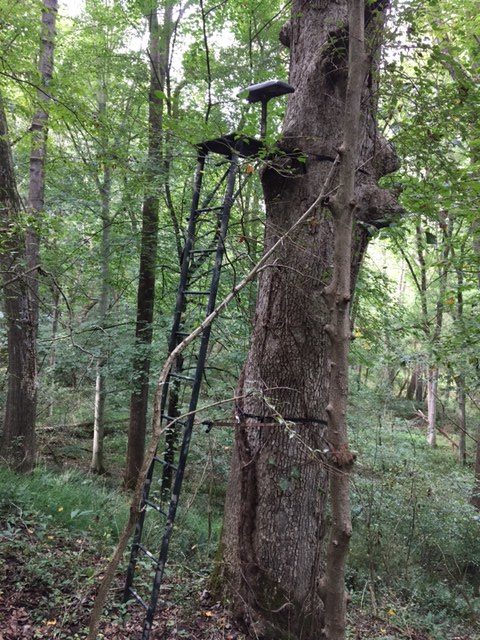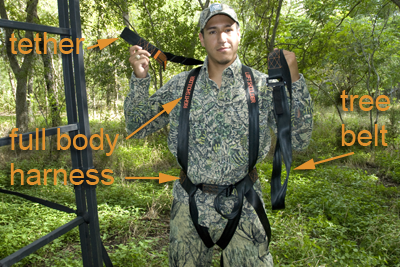11 Oct STAND READY!!!
Sitting still for long periods of time is tough. Most men are ADHD, so it is near impossible for us to not move. As an archer, I improved my success when I learned to sit still and spend the day in the tree.

Fred Bear felt that hunting from an elevated stand was unfair and should have been unlawful. There was a time when the advantage of elevation may have been truer. Deer were not yet conditioned to look up. That is no longer true, and we have all had deer see us sticking onto the side of high tree. Hunting in Fred’s day was about ground blinds, stalking, and still hunting. These tactics are still effective today.
Spending the day in a tree is important but… which tree and where? Great scouting will determine the deer trails, bedding areas, and feeding zones. When the rut kicks in, certain areas seem to have more chasing deer opportunities. Many of these top pick areas are productive every year.
When I think back about some of the old wooden or junky stands I have used in the past, I must give thanks that I am still alive. For years, we never used a safety belt. On windy days, the tees would swing, crack, and bend. Forget about taking a nap. Sadly, most hunting accidents are a result of tree stands. Gravity is not always a hunter’s friend.
One of my favorite stands was in a three-trunk oak tree. I tucked a wooden leaning ladder into the crotch of the three trees and nailed a large branch along both sides as railings. When I wasn’t sitting on my bucket, I would perch onto the rails. One windy evening, I was perched on a rail. The next thing I knew, I was flat on my back 15 feet lower, laying in the leaves. I had no safety strap and was wearing a heavy set of insulated bibs and coat. No injuries to my body, just my pride. That was the last time I hunted without a safety strap. I was lucky!
Here are some great tips to stand by!
Your stand tree needs to be healthy and strong. It doesn’t hurt if your tree produces acorns or nuts that the deer enjoy.
Tree Thickness and size should match your body size. Not only do you want the tree to hide you as you sit, you want a tree strong enough to support your body size.
Never use a dead, damaged, or sick tree as your stand location. Lightning struck trees are dangerous. Look for cracks and damage. Hollow or insect infested trees are also a bad idea.
Use a small screw in hook to hang your bow or weapon at the ready.
A comfortable seat is essential. Set the seat slightly higher than 90 degrees so that you are already in position to stand. This also allows for better blood circulation.
Consider the sun. Are you going to hunt the morning or evening?
Prepare your stands early. Prune shooting lanes and clear trails so that they direct deer toward your kill zone. You are in the deer’s living room, they notice everything.
What shot are you after? If you are a bowhunter, then 30 yards is realistic. As a shotgun hunter, 125 yards is the norm. With a rifle, you may be fine out to 250 yards. Know your weapons, abilities, and skills. Now find a tree that helps you get the shot you are after.
Kinds of Stands
Use a secure and safe stand. Make sure that all welds, bolts, or screws are intact. Loctite your threaded bolts and screws. Test your stands before you put them into the woods. Just because the stand is cheap doesn’t make it a smart value. Stands that have been afield for long periods age and the straps can rot. Treat yourself to a new strap every season.
Leaning ladders have come a long way and do not damage the trees. You only need to get 10-12 feet up. Consider contours when setting your stand. The higher you get the greater the shot angle becomes. Your kill zone becomes more limited and restrictive.
Safety straps are a must. The shoulder and full body harness are best!

Screw in steps and hang on stands are risky Not all landowners want you to damage their trees. Hang on fittings and straps also weaken with age. Bad weather can allow slippage and danger.
Portable climbers are much improved but… Things get sketchy when the trees are wet, icy, or at odd angles. Bark or no bark can be a factor. Go slowly and quietly. Always use your safety strap when going up and down the tree. Spring linked carabiners are handy for fast movement and resetting of your straps. We have all had that moment when the stand slips or shifts.
Use a rope to lift hear and weapons into the stand. Make sure the weapons are unloaded and secure. Lift quietly and secure once aloft.
Homemade wooden stands. These were once the stand of choice. Hammered together with screws or nails. With the price and designs of new metal stands, don’t use wood. The hardware rusts, breaks, and the wood ages and rots. Just too unsafe.
Be Organized. The pack goes under your seat, the weapon is where you expect the deer to come from. Safety belt allows for movement. Calls are around your neck. Whatever your plan is, be consistent. You do not want to be moving around while looking for your grunt call, or…
The worst thing about tree stands is that they force you to commit to one style of hunting. You certainly need to develop your hunting skills so you can find the right tree, but once you are in the canopy, your only option is patience.
In Maryland and Pennsylvania, I lived in tree stands. Since moving to Montana, I almost never use them. Different hunts require different strategies.
You do not always need a tree stand. In many areas that I hunt, there are no trees. Sure, you can erect a tripod but now you stick out like a sore thumb. Having other hunting tactics is a good idea. Be open minded to learn new strategies and skills.
Challenge yourself to become the best hunter you can be.
Montana Grant
For more Montana Grant, find him perched in a tree at www.montanagrantfishing.com.

